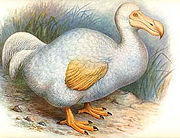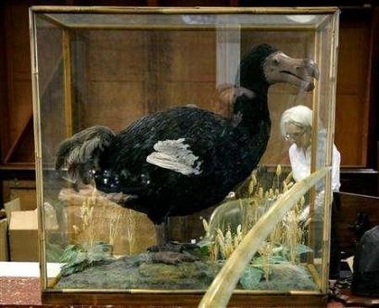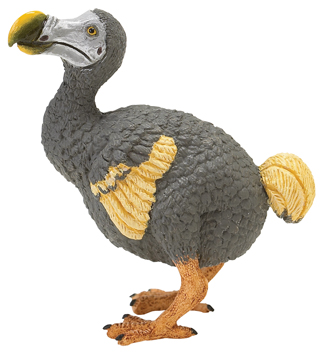
September 12, 2009

The dodo (Raphus cucullatus).
Alan Weston is reporting in today’s Liverpool Daily News that Liverpoolians have a chance to view an exhibition as “dead as a dodo.”

The dodo nicknamed “Fred.” The Natural History Museum, London, photo.
Weston writes that “visitors to World Museum Liverpool can get an idea of what this near-mythical creature looked like after a rare dodo skeleton was put on display. The skeleton is made up of large numbers of bones found in a swamp on the island of Mauritius, in the Indian Ocean. While the dodo has been extinct for more than 300 years, the mounted skeleton itself is believed to have been kept under wraps in the museum’s collection for at least 40 years. It is now on display for a month as part of the Hidden Treasures series, featuring items rarely seen by the public.”

This museum quality replica of the dodo is from the company Safari Ltd.
This is the only mounted skeleton of a dodo anywhere in the world. All others are reconstructions, using goose feathers. The skeleton is quite complete although we have recently discovered that the foot bones have been skilfully carved from wood.
It’s a good skeleton, with an important story. The message is the extinction of flightless species is incredibly easy. They are on an island, and as soon as man comes along with his pigs, guns, and rats, they’re gone.
Everyone knows the dodo from the phrase “dead as a dodo,” but very few will have seen an actual skeleton of one.
Although the last reliable sighting of a living dodo was in the late 17th century, it may one day be possible to reconstruct the species with the ancient DNA from one of these bones.
Dr Clem Fisher, the museum’s curator of vertebrate zoology
The large, flightless pigeons were about 3 feet tall and were killed off by arriving sailors in Mauritius, who slaughtered the birds for food.
The skeleton was put together from the bones of different dodos found in a swamp on the island.
The only part missing is the top of the bird’s skull, or cranium. It was donated to the curator of the then Liverpool Museum in 1866, and has been in the collection ever since.
Dodos would have weighed around 50 pounds, and had grey plumage, a nine-inch beak with a hooked point, tiny wings and a tuft of curly rear feathers, writes Weston.
Cryptozoologically, sightings of birds resembling dodos have been recorded in recent years from some of the islands surrounding Mauritius. Reports of sightings of living dodos in the 1990s on Mauritius prompted William J. Gibbons to mount expeditions to search for them. None were found.
While the dodos will never fly again, perhaps they still do exisit?
^^^^^^^^^^^^^^^^^^^^^

Coming soon – on Sunday, September 13th! Be prepared for some big news. There will be a major announcement about the future of the International Cryptozoology Museum in one day. Your donations are urgently requested. You can’t imagine how much they are needed now! Please, today, donate, by clicking the following button:
Thank you!!
+++
Dodo stamp illos thanks to Pib Burns.
About Loren Coleman
Loren Coleman is one of the world’s leading cryptozoologists, some say “the” leading living cryptozoologist. Certainly, he is acknowledged as the current living American researcher and writer who has most popularized cryptozoology in the late 20th and early 21st centuries.
Starting his fieldwork and investigations in 1960, after traveling and trekking extensively in pursuit of cryptozoological mysteries, Coleman began writing to share his experiences in 1969. An honorary member of Ivan T. Sanderson’s Society for the Investigation of the Unexplained in the 1970s, Coleman has been bestowed with similar honorary memberships of the North Idaho College Cryptozoology Club in 1983, and in subsequent years, that of the British Columbia Scientific Cryptozoology Club, CryptoSafari International, and other international organizations. He was also a Life Member and Benefactor of the International Society of Cryptozoology (now-defunct).
Loren Coleman’s daily blog, as a member of the Cryptomundo Team, served as an ongoing avenue of communication for the ever-growing body of cryptozoo news from 2005 through 2013. He returned as an infrequent contributor beginning Halloween week of 2015.
Coleman is the founder in 2003, and current director of the International Cryptozoology Museum in Portland, Maine.
Filed under Avian Mysteries, Breaking News, Cryptotourism, CryptoZoo News, Extinct, Eyewitness Accounts, Fossil Finds, Living Fossils, Winged Weirdies